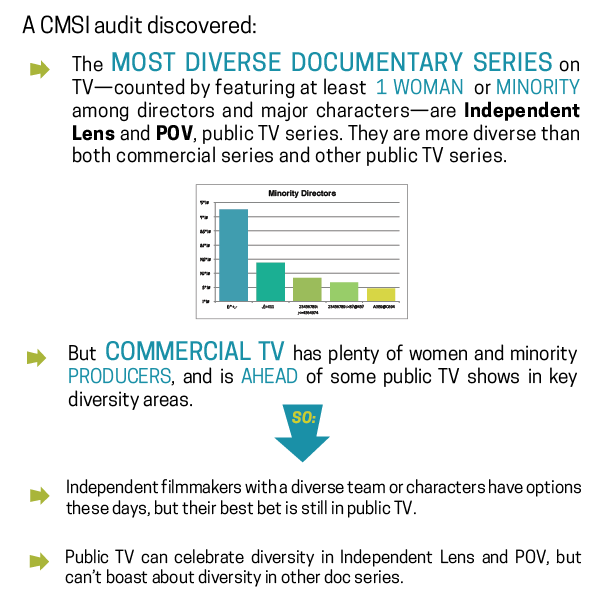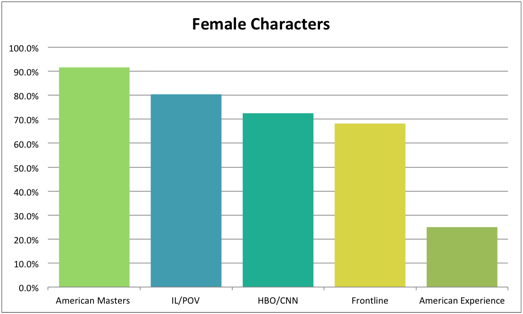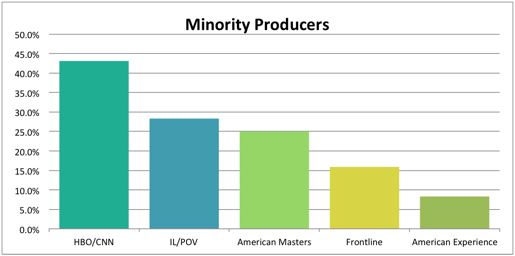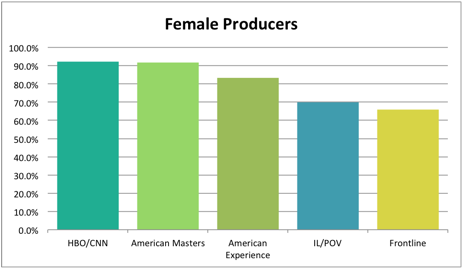Diversity in Independent TV Documentaries: Is Public TV Different?
Table Of Contents
Results
Minorities
Independent Lens and POV, which have similar results, feature many more programs that have at least one minority director than either commercial TV or any other public TV program.
Women
Independent Lens and POV feature more films with at least one women director than HBO and CNN, but not by as large a margin as in minority directors. Also, one other public TV show featured many women directors.
Minority and International Characters
Independent Lens and POV feature more films with at least one minority character or international character of color than both commercial and public TV, with the exception of Frontline, which features many international characters of color.
Producers
In producing, the broad category of work that may add substantial creative content but without authorial credit, commercial TV excels.
Background
Issues of diversity are one potential measure of the differentiation between publicly funded and commercial media, particularly for documentaries. The Corporation for Public Broadcasting (CPB), which channels the federal dollars to stations and programs, proudly announces on its website that “Digital, Diversity, and Dialogue are the framework for public media’s service to America” and founded “to champion the principles of diversity and excellence of programming, responsiveness to local communities, and service to all.”
In U.S. public television, social-issue documentaries are a small element in programming, but historically a large element in defining the difference between public and commercial broadcasting. Many viewpoints and voices, often diverse, have been showcased that otherwise would not have been available to national audiences.
Independents have often opened up space on public broadcasting with pressure that has helped to make public TV distinctively diverse. Independent pressure resulted in the creation of a series showcasing independent work, POV, in 1988. As well, in the same year, at Congress’ behest the Corporation for Public Broadcasting created, after a decade of independent pressure on both the CPB and Congress, the Independent Television Service (ITVS) to co-produce independent work to be offered to programmers of the public service. By 1999, ITVS developed a showcase series, Independent Lens, co-curated with PBS, which has veto power over the programming choices.
The historic diversity of voices and perspectives was at issue in a public TV controversy that surfaced in 2014, around the two series that currently showcase independent work on public TV—Independent Lens and POV. PBS carries both series on prime-time, although only a minority of stations carry the programs and some of those do not carry them when aired. But recently, both series have been threatened with removal from their prime-time spot. Such removal would threaten existing carriage by stations, and ultimately the series’ existence, since the terms of their creation lock them into public broadcasting. Independents argued passionately, as they had in the past, that public TV had an obligation to represent the diversity of the nation on a taxpayer-funded service. After nation-wide protest from independents, non-profits and viewers, PBS changed its position to pledge a one-year commitment to the programs.
But today, with HBO, CNN, Pivot, Netflix, Amazon and many more jockeying for documentaries, is public TV distinctive?
To find out, we counted female and minority participation in commercial and public documentaries.
Methods
We examined 165 documentaries that aired in either the 2014 or 2014-2105 season in the U.S. We focused on social-issue documentaries produced by independent makers, as represented in series that curate authorial works. For commercial TV, we chose HBO Documentaries and CNN Documentaries. For public TV, we chose Independent Lens and POV. These four series are all series seriously considered by independent filmmakers and their agents when deciding on a broadcast partner for the same kind of social-issue work.
We also, for comparison within public TV, selected for analysis three other public TV series featuring social issue documentaries. These series often employ independent producers to work on these programs, and sometimes even select programs based on pitches by them, but maintain control over the ultimate design and look of the program. We chose two series that feature social issues, Frontline and American Experience, and American Masters, an arts series featuring the social context of performance. We chose these other series on public television to see whether curation of independent authorial work was more significant in explaining minority and female representation than the venue of public broadcasting itself.
We asked questions about both minority and female participation, both as directors and producers. In asking about minority makers, our standard was whether at least one member of the relevant group was a U.S. minority within the federal categories. We also asked whether the documentaries featured minority, international and/or female characters in a major role, which was considered as recurring characters who shape the core narrative and motivate the arc of the action or explanation. For international characters of color, we included Middle Eastern. In all cases, any maker or character who occurred in two categories, e.g. minority and female, was counted in both.
We combined results for Independent Lens and POV, whose results were similar, and for HBO Documentaries and CNN Documentaries, which also featured similar results.
Conclusion
These data demonstrate the value of Independent Lens and POV to a service that is partly funded by national, state and local tax dollars and that claims, as the Corporate for Public Broadcasting does, that “Digital, Diversity, and Dialogue are the framework for public media’s service to America” and founded “to champion the principles of diversity and excellence of programming, responsiveness to local communities, and service to all.” They also, however, demonstrate the fragility of that claim, since neither of the two series have commitments from many of the public TV stations to be carried at feed, nor do they have a commitment from PBS for a stable place in the prime-time lineup. As well, other public documentary series do not demonstrate a commitment to diversity in either makers or characters.
Public television, while still a uniquely valuable place for minority and women independent makers and a site for storytelling that otherwise may not reach television publics, has competition from commercial television, at least for more established makers and for women. Although commercial television does not feature as many films with women and minority directors as public authorial TV, it employs more women and minorities in secondary roles than public authorial series do. Although public TV’s independent series showcase many more international figures of color than commercial and outdistance commercial TV for stories featuring women and U.S. minorities, commercial TV showcases more such stories than some other leading public TV documentary series.
Authors
Report by:
Patricia Aufderheide,
University Professor, School of Communication, American University
Center for Media & Social Impact
Caty Borum Chattoo,
Executive in Residence, School of Communication, American University
Creative Director, Center for Media & Social Impact
Kenneth Merrill,
Ph.D. Candidate, Communication Studies, American University







